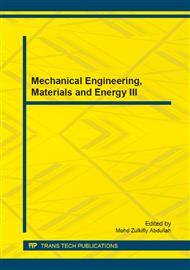p.83
p.88
p.92
p.96
p.100
p.105
p.110
p.115
p.119
Preparation of Magnetic Nanoparticles from Byproduct of Titanium Dioxide-Copperas
Abstract:
A new method for the preparation of Fe3O4 NPs from byproduct of titanium dioxide-copperas was studied in this study. Core-shell structures and chemical composition of the nanoparticles have been investigated by TEM, XRD and FTIR techniques. The results indicated that the Fe3O4 NPs can be synthesized and obtained from copperas by chemical co-precipitation method and have a uniform spherical morphology with an average diameter of about 10 nm. The mole ratio of Fe2+ to Fe3+was one of the most important factors during the chemical co-precipitation processing, which has a great effect on the yield and size distribution of precipitations. The recommended mole ratio f Fe2+ to Fe3+ was 1.75:1. The saturated magnetization of Fe3O4 NPs was 52.8emug-1 at 25°C and this material exhibited excellent magnetic properties. A new way was therefore provided for the comprehensive utilization of the unmarketable copperas. Moreover, the Fe3O4 NPs obtained from the copperas have a big potential in environmental decontamination, medical technology and biological science.
Info:
Periodical:
Pages:
100-104
Citation:
Online since:
December 2013
Authors:
Price:
Сopyright:
© 2014 Trans Tech Publications Ltd. All Rights Reserved
Share:
Citation:


